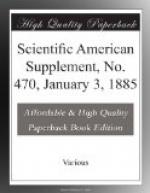Some very practical conclusions may be drawn from the facts now stated. It appears that the oxidation of nitrogenous matter in soil will be confined to matter near the surface. The nitrates found in the subsoil and in subsoil drainage waters have really been produced in the upper layer of the soil, and have been carried down by diffusion, or by a descending column of water. Again, in arranging a filter bed for the oxidation of sewage, it is obvious that, with a heavy soil lying in its natural state of consolidation, very little will be gained by making the filter bed of considerable depth; while, if an artificial bed is to be constructed, it is clearly the top soil, rich in oxidizing organisms, which should be exclusively employed.
The Substances Susceptible of Nitrification.—The analyses of soils and drainage waters have taught us that the nitrogenous humic matter resulting from the decay of plants is nitrifiable; also that the various nitrogenous manures applied to land, as farmyard manure, bones, fish, blood, rape cake, and ammonium salts, undergo nitrification in the soil. Illustrations of many of these facts from the results obtained in the experimental fields at Rothamsted have been published by Sir J.B. Lawes, Dr. J.H. Gilbert, and myself, in a recent volume of the Journal of the Royal Agricultural Society of England. In the Rothamsted Laboratory, experiments have also been made on the nitrification of solutions of various substances. Besides solutions containing ammonium salts and urea, I have succeeded in nitrifying solutions of asparagine, milk, and rape cake. Thus, besides ammonia, two amides, and two forms of albuminoids have been found susceptible of nitrification. In all cases in which amides or albuminoids were employed, the formation of ammonia preceded the production of nitric acid. Mr. C.F.A. Tuxen has already published in the present year two series of experiments on the formation of ammonia and nitric acids in soils to which bone-meal, fish-guano, or stable manure had been applied; in all cases he found the formation of ammonia preceded the formation of nitric acid.
As ammonia is so readily nitrifiable, we may safely assert that every nitrogenous substance which yields ammonia when acted upon by the organisms present in soil is also nitriflable.
Certain Conditions having Great Influence in the Process of Nitrification.—If we suppose that a solution containing a nitrifiable substance is supplied with the nitrifying organism, and with the various food constituents necessary for its growth and activity, the rapidity of nitrification will depend on a variety of circumstances:
1. The degree of concentration of the solution is important. Nitrification always commences first in the weakest solution, and there is probably in the case of every solution a limit of concentration beyond which nitrification is impossible.
2. The temperature has great influence. Nitrification proceeds far more rapidly in summer than winter.




